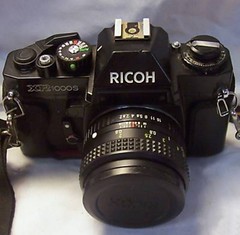Difference between revisions of "Ricoh KR-10"
m (bolding model name) |
(Deleted image by Just Plain Curt - no longer available) |
||
| (4 intermediate revisions by 3 users not shown) | |||
| Line 1: | Line 1: | ||
| − | + | ||
{{Flickr_image | {{Flickr_image | ||
|image_source= http://www.flickr.com/photos/mediumjones/4266871160/in/pool-camerawiki | |image_source= http://www.flickr.com/photos/mediumjones/4266871160/in/pool-camerawiki | ||
| Line 8: | Line 8: | ||
|image_rights= wp | |image_rights= wp | ||
}} | }} | ||
| − | The '''KR-10''' is an [[SLR]] for [[35mm film]] made by [[Ricoh]], beginning in 1980. In some markets it was designated '''Ricoh XR 1000 S'''. The '''KR-10SE''' is a minor variant, in silver and omitting the self-timer. | + | '''''Note''': the [[Ricoh KR-10M|Ricoh KR-10M]] and [[Ricoh KR-10S|KR-10 Super]] are different models'' |
| + | |||
| + | The '''KR-10''' is an [[SLR]] for [[35mm film]] made by [[Ricoh]], beginning in 1980. In some markets it was designated '''Ricoh XR 1000 S'''. The '''KR-10SE''' is a minor variant, in silver and omitting the self-timer. | ||
| − | Like | + | Like the [[Ricoh KR-5 | KR-5]], this model was an attempt to increase sales by cutting costs. Compared to the earlier [[Ricoh XR-2 | XR-2]], the KR-10 still offers [[aperture-priority]] autoexposure; but this is a simpler model, omitting the multiple-exposure control or the aperture-ring sighting window in the viewfinder. The result gained better acceptance outside Japan,<ref>See a [https://translate.google.com/translate?sl=ja&tl=en&u=http://www.ricoh-imaging.co.jp/japan/products/ricoh-filmcamera/cameralist/XR1000S.html machine translation] of the Ricoh history page in Japanese linked below.</ref> including in rebadged form as the [[Sears KSX]]. |
To unlock the shutter, the film wind lever must be pulled outwards. The electronically-timed [[Copal]] shutter provides a wide range of speeds from 1/1000 second to 4 seconds plus B, with [[flash sync]] up to 1/125 sec. (In autoexposure mode, the shutter can stay open for up to 8 seconds). The shutter is dependent on power from two 1.5v LR44/SR44 batteries, without which only the mechanical speeds of "X" (1/90th second) and B may be used. A half-press on the shutter release is needed to activate the exposure indicator needle in the viewfinder. | To unlock the shutter, the film wind lever must be pulled outwards. The electronically-timed [[Copal]] shutter provides a wide range of speeds from 1/1000 second to 4 seconds plus B, with [[flash sync]] up to 1/125 sec. (In autoexposure mode, the shutter can stay open for up to 8 seconds). The shutter is dependent on power from two 1.5v LR44/SR44 batteries, without which only the mechanical speeds of "X" (1/90th second) and B may be used. A half-press on the shutter release is needed to activate the exposure indicator needle in the viewfinder. | ||
| + | |||
| + | ==Notes== | ||
| + | <references/> | ||
==Links== | ==Links== | ||
*[http://www.butkus.org/chinon/ricoh/kr-10/kr-10-splash.htm Ricoh KR-10 manual] from Mike Butkus' [http://www.butkus.org/chinon/ OrphanCameras.com] | *[http://www.butkus.org/chinon/ricoh/kr-10/kr-10-splash.htm Ricoh KR-10 manual] from Mike Butkus' [http://www.butkus.org/chinon/ OrphanCameras.com] | ||
| + | * [https://www.butkus.org/chinon/ricoh/ricoh_kr-10se/ricoh_kr-10se.htm Ricoh KR-10SE PDF manual] at [https://www.butkus.org/chinon/index.html OrphanCameras.com] | ||
In Japanese | In Japanese | ||
| − | *[http://www.ricoh.co.jp/ | + | *[http://www.ricoh-imaging.co.jp/japan/products/ricoh-filmcamera/cameralist/XR1000S.html Ricoh XR 1000 S] at [http://www.ricoh-imaging.co.jp/japan/index.html Ricoh Japan] |
| Line 27: | Line 33: | ||
|image_text= As '''Ricoh XR 1000 S''' | |image_text= As '''Ricoh XR 1000 S''' | ||
|image_by= Michael Brannon | |image_by= Michael Brannon | ||
| − | |||
| − | |||
| − | |||
| − | |||
| − | |||
| − | |||
| − | |||
| − | |||
|image_rights= wp | |image_rights= wp | ||
}} | }} | ||
| − | [[category:Japanese 35mm SLR]] [[Category:Ricoh|KR-10]] [[Category:Ricoh | + | [[category:Japanese 35mm SLR]] |
| + | [[Category:Ricoh|KR-10]] | ||
| + | [[Category:K|KR-10 Ricoh]] | ||
| + | [[Category:K mount]] | ||
Latest revision as of 02:17, 16 January 2022

|
| image by Mediumjones (Image rights) |
Note: the Ricoh KR-10M and KR-10 Super are different models
The KR-10 is an SLR for 35mm film made by Ricoh, beginning in 1980. In some markets it was designated Ricoh XR 1000 S. The KR-10SE is a minor variant, in silver and omitting the self-timer.
Like the KR-5, this model was an attempt to increase sales by cutting costs. Compared to the earlier XR-2, the KR-10 still offers aperture-priority autoexposure; but this is a simpler model, omitting the multiple-exposure control or the aperture-ring sighting window in the viewfinder. The result gained better acceptance outside Japan,[1] including in rebadged form as the Sears KSX.
To unlock the shutter, the film wind lever must be pulled outwards. The electronically-timed Copal shutter provides a wide range of speeds from 1/1000 second to 4 seconds plus B, with flash sync up to 1/125 sec. (In autoexposure mode, the shutter can stay open for up to 8 seconds). The shutter is dependent on power from two 1.5v LR44/SR44 batteries, without which only the mechanical speeds of "X" (1/90th second) and B may be used. A half-press on the shutter release is needed to activate the exposure indicator needle in the viewfinder.
Notes
- ↑ See a machine translation of the Ricoh history page in Japanese linked below.
Links
- Ricoh KR-10 manual from Mike Butkus' OrphanCameras.com
- Ricoh KR-10SE PDF manual at OrphanCameras.com
In Japanese

|
| As Ricoh XR 1000 S image by Michael Brannon (Image rights) |